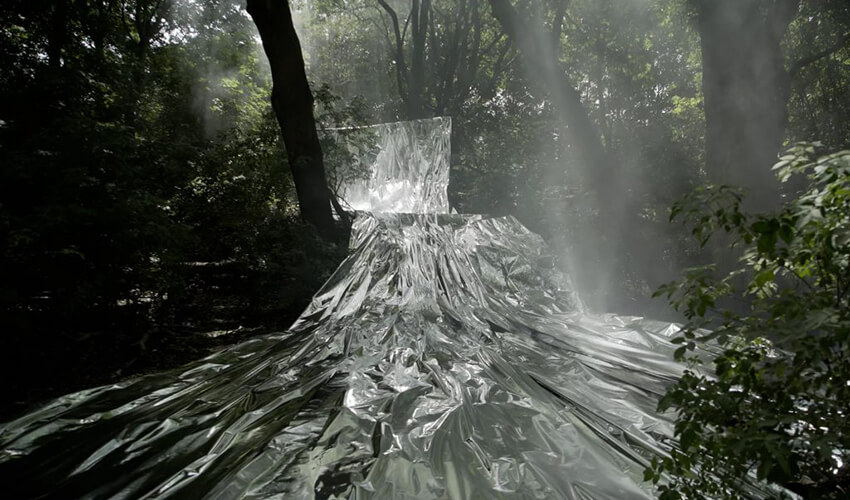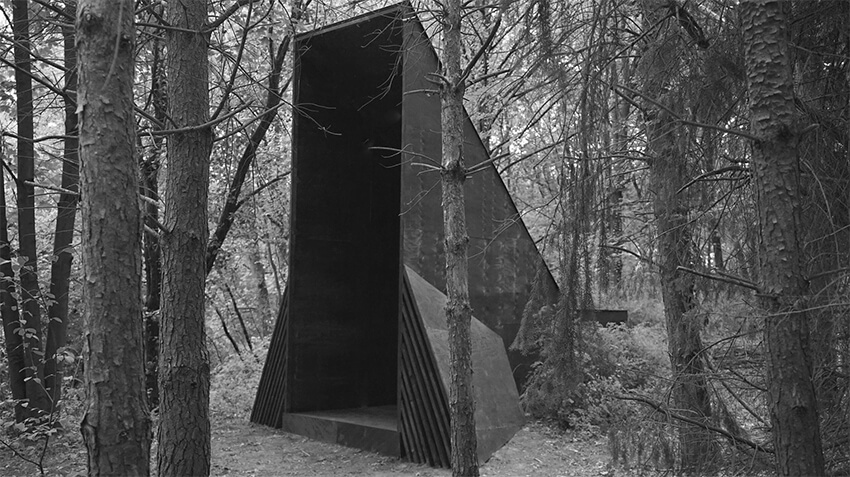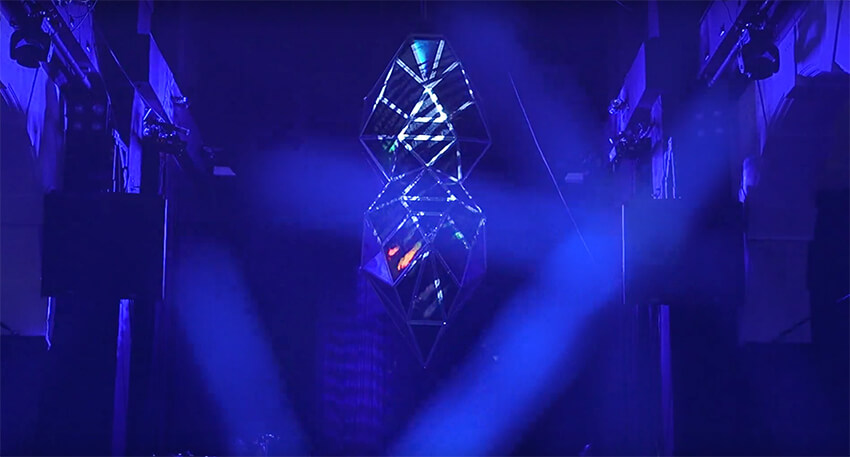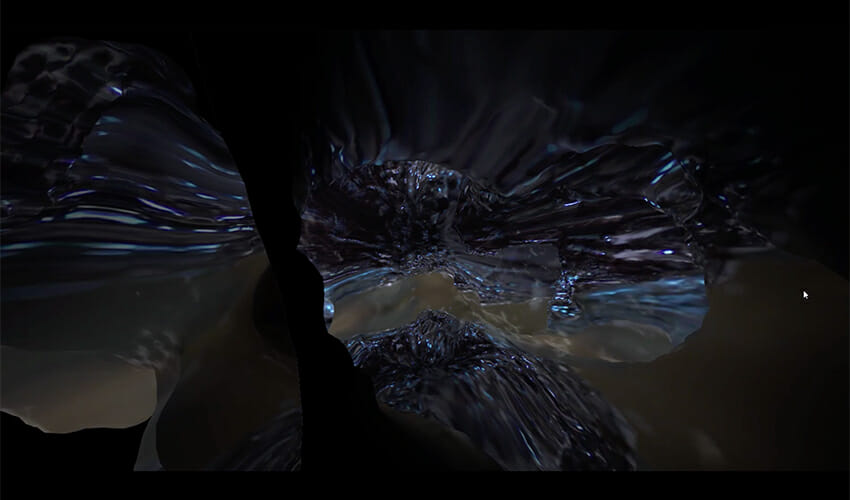Interview by Živa Brglez

Nature and culture were for centuries regarded as opposites and held as separate spheres. Within the last century, this view slowly shattered and shifted to a more ecological way of seeing life: as two interconnected entities that must be viewed in regard to their inner relationships and interactions, as a complexly separated whole. Something uneasy yet beautiful happens when the two are conjoined in artistic works. Especially in the works of Amsterdam-based artist Heleen Blanken.
Blanken works with a range of mediums but mostly within media cinematography, photography and installation art. Her source of inspiration, content and form is nature in all her characters and transformations. It is something atmospheric, meditative and mysterious – disturbing and appealing at the same time. Especially when the cultural, most frequently industrial, part intervenes.
Very illustrative of this point is her When Water Falls installation, in which she reproduced and reinterpreted the river in the middle of a forest as a stream of plastic metallic foil, but somehow still managed to preserve the romantic contemplative moment of depicting rivers forest-deep.
The work doesn’t only show us the reflection (literally and figuratively) of plastic waste and pollution, but it also demonstrates the nature’s power to animate something as hollow and lifeless as a plastic metallic foil and thus completely shakes the nature/culture dichotomy. Blanken also drew on religious overtones when creating The Chapel in 2018. The construction was made to honour the dying forest in Tilburg in the Netherlands. It is not so much a pantheistic sacred architecture as it is an expression of appreciation of nature’s strength.
In her practice, she often builds with small elements and paltry moments collected from nature. Through her works, abstract forms and patterns lose all its usefulness and purpose and become cornerstones of something inherently beautiful. They lose their character as a tool and gain their personas as aesthetic objects on themselves. The gaze that constituted them is sometimes even microscopic – as was in her visual design work she did for a live show of Know V. A. music group.
She has a deep-rooted relationship with auditory. In her installations, she often conjoins visual with auditory perception. For example, in Ousia (2016), a meditative atmospheric installation experiment that dealt with the dystopian idea of humanity’s disconnect from nature and the beginning of the new, post-consumerist era, she has employed industrial sounds as sounds to mimic nature (she has collaborated with Aquatic, the Amsterdam-based producer). Furthermore, she has made several music videos in which she has masterfully matched her aesthetics with sound compositions of various musical artists.
Recently, Blanken has partnered up with Slagmann, which is a new collaboration of producer Talismann and music ensemble Slagwerk Den Haag. Together they made the music album Krysalis, which is an “adventurous synthesis of hypnotizing rhythm patterns and organic soundscapes” when interpreted live joined with “captivating scenography” that truly makes it a kind of “ritualistic experience”, as the artists are inclined to call it. It is a take on innovative use of sounds that produce audio effects ranging from dream-like features to dark sides of electronic and classical minimal music.
Talismann produced the album using an analogue set of (percussive) instruments from Slagwerk den Haag. Blanken contributed visual identity and scenography of the live show, in which she is heavily relying on strong metaphorical quality chrysalis – the pop in which a caterpillar turns into a butterfly. The album was released through Talismann Records on April 29th.



Right: Habitat project
Your artistic practice is deeply influenced by the complexity of the separation between humanity and the natural environment. What are your main aims as new media artists working between technology and nature?
When creating new work, my aim is to translate my curiosity and evoke an experience for the spectator, something otherworldly. And maybe even creating an intangible atmosphere showing the complexity and distance we have towards the world around us. I think we can explore in our work, wonder and discover… we can present a different angle on the topic… but we are not scientists. The world around us is, to a certain point, graspable, but even with the best technologies, we are still scratching the surface. Technology gives a lot of possibilities. Technology helps me to translate my view on nature in ways I am still discovering.
What aspects of nature most fascinates or inspire you?
I love the perpetual motion of nature and the way the natural world forms itself around us. that keeps my mind occupied. And, for instance, the power that resides in the middle of our planet. A liquid, magnetic core, but deeper, there are solid crystals pointing north. Those constructs are exhilarating, just like all the mathematical constructs in nature’s growth.
For me, that is enchanting. When you enter nature at its roughest, you experience its power. We can explore this from a distance, but we will never fully grasp it completely, I believe. I think my work is an example of how we contemplate ideas of nature and try to give life to alternative visions.
You’ve created the visual identity of KRYSALIS, the new album by Slagmann. What was the intellectual process behind the inception of this part of the project?
Krysalis is an audiovisual performance of Slagmann, which is a new collaboration between Talismann and Slagwerk Den Haag. It is a mesmerising cross-pollination between ritualistic percussion and drum machines. I designed the scenography for them, and we created a 3-meter-long sculpture that dominates the show and acts almost like a guide through the music.
We wanted to create a show where the fascination of mathematical perfection shines through. Where the “Krysalis” becomes a symbol of transformation while touching on the balance between the light and dark sides of nature. We are aiming to take the spectators on a ritualistic experience.
You also developed the live show scenography. What were the biggest challenges for its development?
The biggest challenge was to get the whole piece into action. It is a sculpture of 3.20 by 1.40, and she is pretty heavy. We started with a small drawing, and together with Paulus van der Heijden, we translated it into a small model. With a lot of trial and error and many sleepless nights, we formed the sculpture. It was a great process, but it took its toll on all of us, haha.
We are particularly interested also in your installation work. What do you expect from the audience interacting with your installations?
In my past work, the audience is a spectator and not a participant. But at the moment, I am working on my first fully digital art installation in collaboration with Naivi and Dasha Rush. We have created a completely new world within the NAP framework. We also build the software for the Kyrsalis live performance with this framework. It is a beautiful new world, and I am spending days in the software at the moment, is an exciting place to hide in.
The work documents and visualises the natural growth processes of organisms on the basis of 3D scans and animations from the natural history archives of the Naturalis Biodiversity Center in Leiden. It shows biological growth processes in real-time and deals with the transient nature of evolutionary mobility.
We want to create an event where boundaries fade. In the installation, animations, video and soundscapes simulate behaviours based on the processes within nature. The installation can be influenced by the presence of the visitor. People can experience the work from a distance or dive into a dialogue with the work. The number of visitors, their position in the room and their movements influence how images and sounds form and will move.
This dynamic interaction is, I think, very interesting. But it will not always give you what you anticipate. The feedback of the installation can be very subtle, and the visitor can initially ponder whether the installation responds to her/him or not. This reflects the autonomy of nature. We are in the last phase of the work. It is almost finished.
From programmable matter, DNA biocomputing and biological design, and the human interaction with digital interfaces, the material and biological seem to be more and more blending with the digital. Where do you think we are headed in terms of the new digital materialism?
There are so many options presenting themselves at this moment. I hope people will make intelligent choices with the knowledge that they gather. I think I only can say at this point we live in exciting times.
What is your chief enemy of creativity?
I think when you lose the sense of belonging in life. And also, being too comfortable in life can be a destroyer of creativity, I think.
You couldn’t live without…
My cats, family and walks in the forest.






